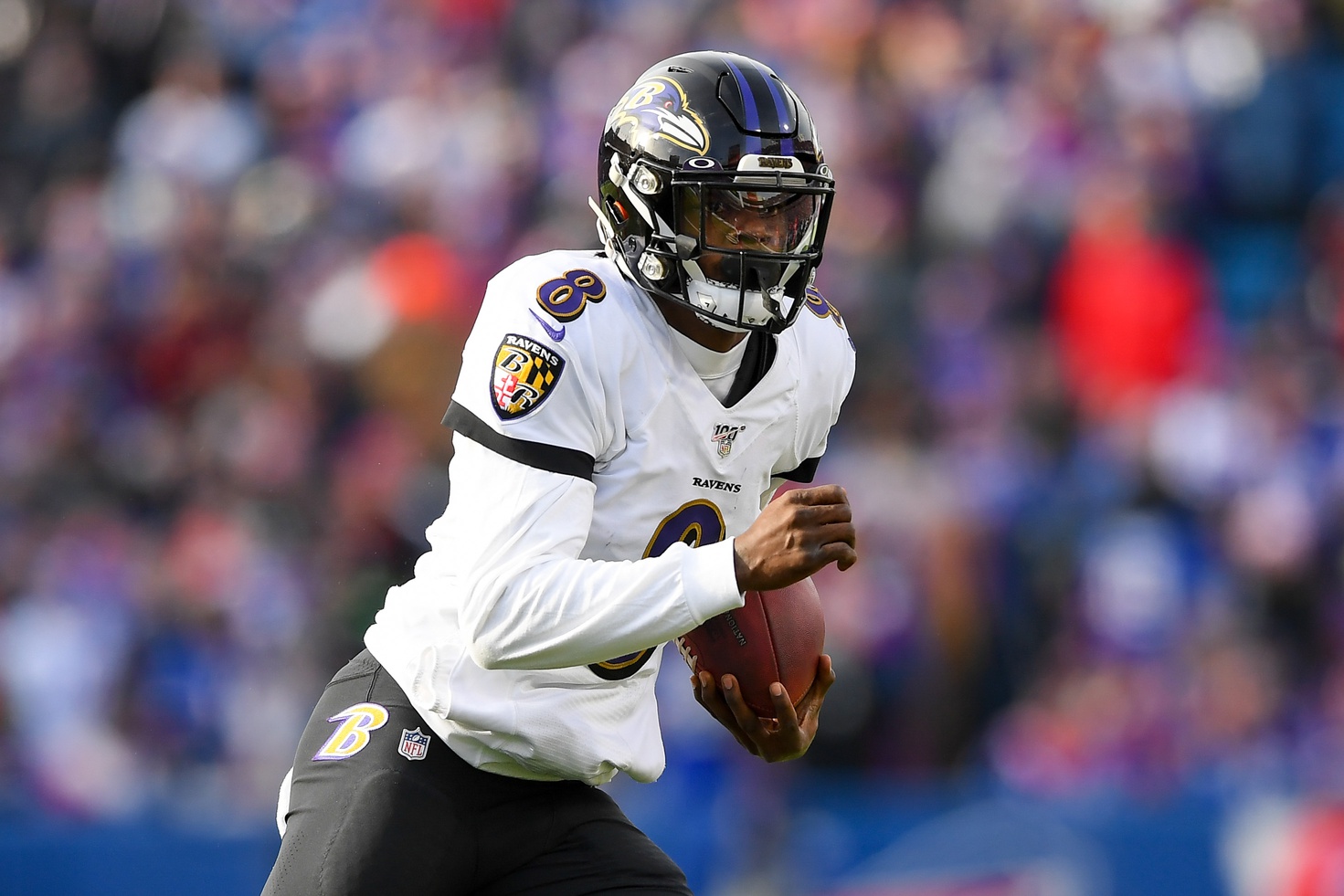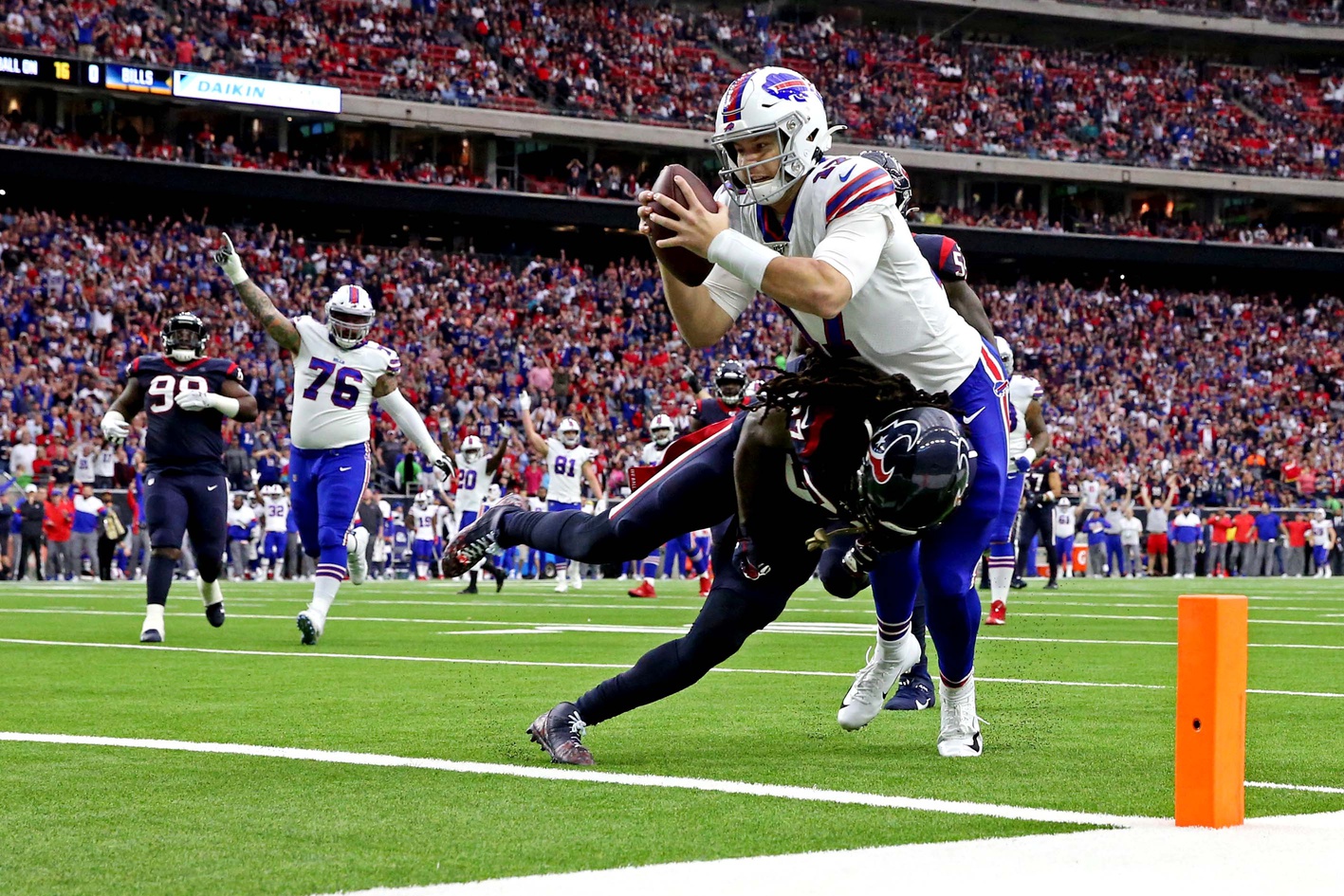An upward trend emerging in fantasy football is acquiring a quarterback with a dual-threat rushing ability.
The way that most fantasy football formats reward fantasy points heavily favors quarterbacks who cannot only accumulate yards through the air but also with their legs. And more and more quarterbacks are entering the NFL with this specific skill set. Last season alone, we saw three rookie quarterbacks rush for more than 280 yards (Kyler Murray, Gardner Minshew and Daniel Jones).
So, how do those dual-threat quarterbacks influence running backs? Because running backs — unlike the quarterback position — are the real difference-makers in fantasy football.
By collecting all the rushing data from every single quarterback in 2019, I have discovered specific metrics that correlate for running backs, based on the rushing statistics of the quarterbacks they play with.
This article outlines the data-collection process, analysis and major takeaways that you can use when evaluating running backs who play with those mobile quarterbacks. Among other things, you will learn how mobile quarterbacks like Lamar Jackson and Josh Allen influence a running back’s targets, rushing yards, fantasy points per snap, yards per route run and goal-line usage.
[Editor’s note: Subscribe to PFF ELITE today to gain access to PFF’s Premium Stats and new Player Grades experience in addition to the 2020 NFL Draft Guide, 2020 Fantasy Rookie Scouting Report, PFF Greenline, all of PFF’s premium article content and more.]

Quarterback Influence on Running Backs
A common theme behind the running back production in comparison to rushing quarterbacks is that the quarterbacks create lanes for their running backs, thus improving overall production. After all, running back Mark Ingram II was dominant on the ground for the Ravens in 2019 behind the league’s best rushing quarterback, Lamar Jackson.
One question I was interested in addressing was, how does the rushing quarterback influence the running back’s role in the passing game? In PPR leagues, should we be targeting running backs with mobile or non-mobile quarterbacks? What kind of receiving production should we expect from these running backs? If we look back at the 2019 Baltimore Ravens and Los Angeles Chargers, we can get an idea of the two ends of the spectrum.
Baltimore ranked dead last in running back targets, and they were led by the most mobile quarterback in the NFL. Meanwhile, Los Angeles — led by Philip Rivers, who is arguably the least mobile quarterback in the NFL — led the NFL in targets to the running back position. I was able to develop similar results when I analyzed all 2019 teams. But before sharing the findings, I will first explain the data I collected.
Data Collection
When collecting 2019 team quarterback rushing metrics, I divided them into six categories from Weeks 1-16 for each team. This collection goes beyond just total quarterback rushing attempts and expands to include scrambles and yardage totals to provide a better context that is unique to PFF.
1. Designed rushing attempts
2. Yardage accumulated on designed runs
3. Total rushing yards
4. Scrambles
5. Scramble yards
6. Aggregate attempts
Once compiled, I could now compare them to the running back metrics to find either a negative or positive correlation relative to quarterback rushing. The first comparison shows the relationship between quarterback rushing and the total team running back targets.
Key Findings
In 2019, there was a moderate negative correlation ranging from -0.39 to -0.54. Below is the order of the strongest to the weakest correlation:
- Quarterback scramble yards vs. running back targets: -0.54
- Quarterback total rushing yards vs. running back targets:-0.52
- Quarterback aggregate attempts vs. running back targets: -0.51
- Quarterback scrambles vs. running back targets: -0.48
- Quarterback designed attempts vs. running back targets: -0.42
- Quarterback designed rush yards vs. running back targets: -0.39
The strongest correlation was between quarterback scramble yards and running back targets. Overall running back targets saw the largest impact of all the running back metrics that I analyzed. Specifically, it was the quarterbacks who scrambled for the most yards who targeted the running back position the least. In 2019, the top scramblers in terms of yardage included Jackson, Josh Allen, Deshaun Watson, Minshew and Russell Wilson. So, for a running back like Devin Singletary, playing with a quarterback who scrambles like Allen will hurt his volume as a receiver.
Additionally, I also tested the running back target leader for each team. This resulted in finding a weaker negative correlation, suggesting that if a running back is not in a timeshare, they can overcome the volume concerns that come with a mobile quarterback. A perfect example of this is Saquon Barkley in New York. However, this also highlights that running backs who are competing for touches as receivers on teams with mobile quarterbacks might be in trouble. An example of this would be Leonard Fournette, as the Jacksonville Jaguars added pass-catching back Chris Thompson this offseason.
The other running back statistics I looked at also presented some interesting findings. Rushing yards for running backs had only a slightly positive correlation between 0.04 and 0.09.
This suggests that running backs do not gain a massive amount of total rushing yards when they are paired with mobile quarterbacks. Fantasy points per snap for running backs drew a larger negative correlation and came in at -0.35, which was specifically regarding total scrambles by the quarterback.
Quarterback scrambling also impacted running backs’ yards per route run and goal-line usage. The negative correlation came in at -0.37 for both metrics.
There were other PFF metrics I analyzed, but the correlation findings were not strong enough to have any major takeaways like the relationship with rushing yards. PFF rushing grade, yards after contact, elusive rating, breakaway percentage and red-zone usage were barely influenced by mobile quarterback play.

Fantasy Implications
So, what does this all mean for fantasy? First, it means that the presence of a mobile quarterback is going to limit targets to running backs in the passing game. That should be the first consideration when looking at any team’s mobile quarterback-running back relationship, and not the “open up lanes” fallacy.
Additionally, we saw a decrease in yards per route run and fantasy points per snap. These quarterbacks also hurt running backs’ volume at the goal line. Having a mobile quarterback is going to limit the most important touches for running backs: receptions and goal-line carries.
Overall, it limits the upside of the running back position, and the top-24 PPR running backs from 2019 support this statement. Of that group of running backs, here are some alarming truths in regard to their relationships with mobile quarterbacks: 14 (58%) had a quarterback rank in the bottom half of the league in scramble yards, and 13 (54%) had a quarterback rank in the bottom half in terms of aggregate rushing attempts.
What is even more alarming is the top-eight backs in PPR. All of them except for Derrick Henry had quarterbacks who ranked in the bottom half of the league in either scramble yards, aggregate attempts or total yardage. In the top-12, nine also fit this description, and of the top 20, just five running backs had what is considered a mobile quarterback on their team.
Conclusion
If you are looking for elite running back production in 2020, you are better off avoiding backfields with mobile quarterbacks, especially ones who scramble. An under-the-radar element to how Christian McCaffrey finished as the RB1 in 2019 was that none of his quarterbacks could run and were forced to check it down to him.
With Tyrod Taylor at quarterback, Austin Ekeler’s targets are likely to decrease in Los Angeles. Conversely, with Rivers in Indianapolis, there could be more receiving work for Nyheim Hines. This concept can even be applied to one of the top backs for 2020 — Kenyan Drake.
Drake scored more touchdowns (eight) than any Arizona Cardinal did in 2019, and he played in just eight games. He also averaged over four targets per game. Both seem unlikely to sustain, due to both the addition of DeAndre Hopkins and the results I have shown you. Drake might be the most impacted running back by mobile quarterback play in 2020, and not in the way many would initially think.



 © 2025 PFF - all rights reserved.
© 2025 PFF - all rights reserved.